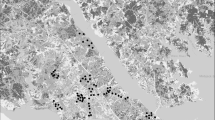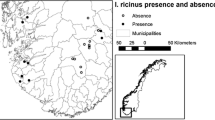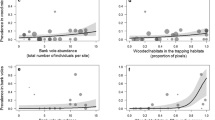Abstract
The landscape features of residential properties within two communities were studied in relation to the abundance of the tick vector Ixodes scapularis. Habitat types of 400 properties, located in a Lyme disease endemic area of Westchester Co., New York, USA, were categorized into lawn, ornamental, ecotone, woods, and stone wall as measured from aerial photographs and sampled for nymphal-stage ticks. Logistic regression results indicate that presence or absence of ticks is influenced by the proportion of either lawn or woodland, and total woodland area. Poisson regression results indicate the abundance of nymphs is negatively associated with proportion, area, and patch frequency of lawn, and positively associated with proportion, area, and patch frequency of woodland. Predictions of tick presence and abundance from landscape features at the scale of individual property is useful for implementing disease prevention measures.
Similar content being viewed by others
References
Adler, G.H., S.R. Telford III, M.L. Wilson and A. Spielman, 1992. Vegetation structure influences the burden of immature Ixodes dammini on its main host, Peromyscus leucopus. Parisitology 105: 105–110.
Allport, S. 1990. Sermons in stone: the stone walls of New England and New York. W.W. Norton and Company, Inc., New York.
Barbour, A.G. and D. Fish, 1993. The biological and social phenomenon of Lyme disease. Science 260: 1610–1616.
Barry, R.E. and E.N. Francq, 1980. Orientation to landmarks within the preferred habitat by Peromyscus leucopus. Journal of Mammalogy 61: 292–303.
Battaly, G.R. and D. Fish, 1993. Relative importance of bird species as hosts for immature Ixodes dammini (Acari: Ixodidae) in a suburban residential landscape of southern New York State. Journal of Medical Entomology 30: 740–747.
Centers for Disease Control. 1991. Lyme disease surveillance-United States, 1989–1990. Morbidity and Mortality Weekly Report 40: 417–421.
Coblentz, B.E. 1970. Food habits of George Reserve deer. Journal of Wildlife Management 34: 535–540.
Curran, K.L., Fish, D. and Piesman, J. 1993. Reduction of nymphal Ixodes dammini (Acari: Ixodidae) in a residential suburban landscape by area application of insecticides. Journal of Medical Entomology 30: 107–113.
Dennis, D.T. 1991. Lyme disease-tracking an epidemic. Journal of the American Medical Association 266: 1269–1270.
Donohue, J.G., J. Piesman and A. Speilman, 1986. Reservoir competence of white-footed mice for Lyme disease spirochetes. American Journal of Tropical Medicine and Hygiene 36: 94–98.
Duffy, D.C., S.R. Campbell, D. Clark, C. DiMotta and S. Gurney, 1994. Ixodes scapularis (Acari: Ixodidae) deer tick mesoscale populations in natural areas: Effects of deer, area, and location. Journal of Medical Entomology 31: 152–158.
Falco, R.C. and D. Fish, 1988. Prevalence of Ixodes scapularis near the homes of Lyme disease patients in Westchester County, New York. American Journal of Epidemiology 127: 826–830.
Falco, R.C. and D. Fish, 1992. a comparison of methods for sampling the deer tick, Ixodes dammini in a Lyme disease endemic area. Experimental and Applied Acarology 14: 165–173.
Fish, D. 1993. Population ecology of Ixodes dammini In: Ecology and Environmental Management of Lyme Disease (Edited by H.S. Ginsberg), 25–42. Rutgers University Press, New Brunswick, NJ.
Fish, D. and T.J. Daniels, 1990. The role of medium-sized mammals as reservoirs of Borrelia burgdorferi in southern New York. Journal of Wildlife Diseases 26: 339–345.
Fish, D., T.J. Daniels, D.H. Frank and R.C. Falco, 1992. Ecology of Lyme disease in the suburban residential landscape of southern New York state. In: Proceedings First International Conference on Tick-Borne Pathogens at the Host Vector Interface (Edited by U.G. Munderloh and T.J. Kurtti), 274–281. University of Minnesota College of Agriculture, Department of Entomology and Minnesota Extension Service, St. Paul, MN.
Fish, D. and R.C. Dowler, 1989. Host associations of ticks (Acari: Ixodidae) parasitizing medium-sized mammals in a Lyme disease endemic area of southern New York. Journal of Medical Entomology 26: 200–209.
Glass, G.E., J.M. Morgan III, D.T. Johnson, P.M. Noy, E. Israel and B. Schwartz, 1992. Infectious disease epidemiology and GIS: A case study of Lyme disease. Geo Info Systems Nov./Dec.: 65–69.
Ginsburg, H.S. and C.P. Ewing, 1989. Habitat distribution of Ixodes dammini (Acari: Ixodidae) and Lyme disease spirochetes on Fire Island, New York. Journal of Medical Entomology 26: 183–189.
Jongman, R.H.G., C.J.F. ter Braak and O.F.R. van Tongeren, 1987. Data analysis in community and landscape ecology. Pudoc, Wageningen, Holland.
Kingsley, N.P. 1985. A forester's atlas of the Northeast. General Technical Report NE-95, U.S. Department of Agriculture, Forest Service, Northeastern Forest Experiment Station, Broomall, Pa.
Kitron, U., J.K. Bouseman and C.J. Jones, 1991. Use of the ARC/INFO GIS to study the distribution of Lyme disease ticks in an Illinois county. Preventive Veterinary Medicine 11: 243–248.
Lastavica, C.C. 1992. Deer, ticks, and Lyme disease. New York State Journal of Medicine 92: 2–4.
Lees, A.D. 1943. Water balance in Ixodes ricinus and certain other species of ticks. Parisitology 37: 1–20.
Magnarelli, L.A., J. Anderson, K. Hyland, D. Fish and J. McAninch, 1988. Serologic analyses of Peromyscus leucopus, a rodent reservoir of Borrelia burgdorferi, in northeastern United States. Journal of Clinical Microbiology 26: 1138–1141.
Maupin, G.O., D. Fish, J. Zultowsky, E.G. Campos and J. Piesman, 1991. Landscape ecology of Lyme disease in a residential area of Westchester County, New York. American Journal of Epidemiology 133: 1105–1113.
McCaffery, K.R., J. Tranetzki and J. Piechura Jr. 1974. Summer foods of deer in northern Wisconsin. Journal of Wildlife Management 38: 215–219.
McCullagh, P. and J.A. Nelder, 1983. Generalized linear models. Chapman and Hall, London, England.
Merriam, G. and A. Lanoue, 1990. Corridor use by small mammals: field measurement for three experimental types of Peromyscus leucopus. Landscape Ecology 4: 123–131.
Oliver, J.H. Jr., M.R. Owsley, H.J. Hutcheson, A.M. James, C. Chen, W.S. Irby, E.M. Dotson and D.K. McLain, 1993. Conspecificity of the ticks Ixodes scapularis and I. dammini (Acari: Ixodidae). Journal of Medical Entomology 30: 54–63.
Pavlovsky, E.N. 1966. Natural nidality of transmissible diseases, with special reference to the landscape epidemiology of zooanthroponses. N.D. Levine(editor). University of Illinois Press, Urbana and London.
Persing, D.H., S.R. Telford III, P.N. Rys, D.E. Dodge, T.J. White, S.E. Malawista and A. Spielman, 1990. Detection of Borrelia burgdorferi DNAin museum specimens of Ixodes dammini ticks. Science 249: 1420–1423.
Robinson, G.R., R.D. Holt, M.S. Gaines, S.P. Hamburg, M.L. Johnson, H.S. Fitch and E.A. Martinko, 1992. Diverse and contrasting effects of habitat fragmentation. Science 257: 524–526.
Shoumatoff, A. 1979. Westchester, Portrait of a County. Random House, Inc., New York.
Sillings, J. 1982. White-tailed deer studies in a suburban community: Ground counts, impacts on natural vegetation and electric fencing to control browsing. University of Minnesota Thesis, Minneapolis.
Sinclair, N.R., L.L. Getz and F.S. Bock, 1967. Influence of stone walls on local distribution of small mammals. University of Connecticut Occasional Papers of the Biological Science Service 1: 43–62.
Spielman, A., M.C Wilson, J.F. Levine and J. Piesman, 1985. Ecology of Ixodes dammini-borne human babesiosis and Lyme disease. Annual Review of Entomology 30: 439–460.
Stafford, K.C. III and L.A. Magnarelli, 1993. Spatial and temporal patterns of Ixodes scapularis (Acari: Ixodidae) in southeastern Connecticut. Journal of Medical Entomology 30: 762–771.
Wilson, M.L., G.H. Adler and A. Spielman, 1985. Correlation between deer abundance and that of the deer tick Ixodes dammini (Acari: Ixodidae). Annals of the Entomological Society of America 78: 172–176.
Author information
Authors and Affiliations
Rights and permissions
About this article
Cite this article
Frank, D.H., Fish, D. & Moy, F.H. Landscape features associated with lyme disease risk in a suburban residential environment. Landscape Ecology 13, 27–36 (1998). https://doi.org/10.1023/A:1007965600166
Issue Date:
DOI: https://doi.org/10.1023/A:1007965600166




